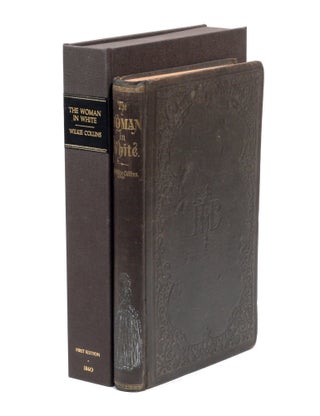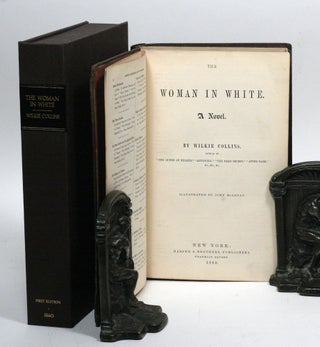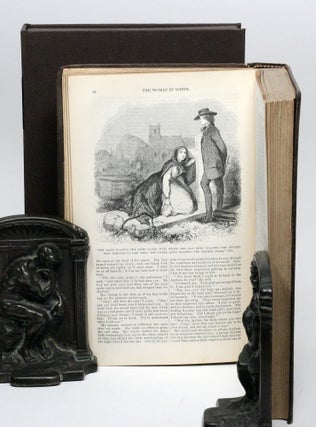The Woman in White
“I had now arrived at that particular point of my walk where four roads met… when, in one moment, every drop of blood in my body was brought to a stop by the touch of a hand laid lightly and suddenly on my shoulder from behind me. I turned on the instant, with my fingers tightening round the handle of my stick. There, in the middle of the broad, bright high-road…stood the figure of a solitary woman, dressed from head to foot in white garments, her face bent in grave inquiry on mine, her hand pointing to the dark cloud over London, as I faced her. I was far too seriously startled by the suddenness with which this extraordinary apparition stood before me, in the dead of night and in that lonely place, to ask what she wanted. The strange woman spoke first. ‘Is that the road to London?’”
-The Woman in White, Wilkie Collins
“I have read this book, with great care and attention…You know what an interest I have felt in your powers from the beginning of our friendship, and how very high I rate them: I know that this is an admirable book, and that it grips the difficulties of the weekly portion and throws them, in masterly style. No one else could do it, half so well. I have stopped in every chapter to notice some instance of ingenuity, or some happy turn of writing; and I am absolutely certain that you never did half so well yourself…So go on and prosper, and let me see some more when you have enough (for your own satisfaction), to show me!...One of these days, please God, we may do a story together...”
-Charles Dickens, in a letter to Wilkie dated 7 January 1860
SCARCE FIRST AMERICAN EDITION, FIRST STATE WITH THE FIRST ISSUE BINDING of one of the first and most influential detective novels. A beautiful copy.
Note: We can find no other examples of the first issue with first state ads in public auction records.
After the publication of The Woman in White William Wilkie Collins earned an international reputation as a master of his craft, a pioneer of detective writing and a creator of a new genre. Born in London in 1824, he was the son of a well-known landscape painter and a former governess. When he was twelve his family spent two years in Italy and France and Collins became fluent in French and Italian and learned more “among the scenery, the pictures, and the people, than I ever learned at school.” His family returned to England when Collins was fourteen and as a boarding school student he told nightly stories to appease the dormitory bully. He later recalled that “it was this brute who first awakened in me, his poor little victim, a power of which but for him I might never have been aware...When I left school I continued story telling for my own pleasure." (Collins, The Legacy of Cain)
Known as a novelist, Collins was also a playwright, a journalist and in 1851 was recruited as an actor for one of Charles Dickens's amateur theater productions. Impressed with Collins’s writing, Dickens took him under his wing, later crediting Collins with helping him to craft more skillful and suspenseful plot structures in A Tale of Two Cities (1859) and Great Expectations (1860–61). Their friendship proved to be one of the most important relationships of Collins’s life. Collins became a regular contributor to Dickens's periodicals “Household Words” and “All the Year Round” and in 1856 Collins spent six weeks in Paris, living next door to Dickens and his family. During that time they visited theaters, music halls and book stalls where Collins found the records of French courtroom trials which inspired the plot of The Woman in White.
In 1859 and 1860 The Woman in White was published in serialized form in Dickens’s “All the Year Round” and concurrently in “Harper's Weekly.” In mid-August of 1860 it was published in three volumes by London’s Sampson Low, Son, & Co. and two weeks later in a single volume by Harper & Company in New York. This Harper’s first American edition is considered more authentic because it follows the original “All the Year Round” text much more closely than the Sampson Low edition. In contrast to the significantly altered Sampson Low versions, Harper & Company reissued this edition for some years, retaining certain errors of chronology, including those pointed out by The New York Times and The Guardian. The American edition was illustrated by John McLenan, a noted caricaturist who produced images for novels by Collins and Dickens. Harper eventually revised and published a uniform edition of Collins’s works on the occasion of his visit to America in 1873. (Gasson, “The Woman in White – A Chronological Study”)
Enthralling readers for generations, The Woman in White is a deviously plotted story of an affable art tutor, Walter Hartright, who encounters a lost woman, clad in all white, on the streets of London. He reports her to the authorities only to discover that she had escaped from an asylum. Later, Walter is hired as an art teacher for Laura, who looks stunningly similar to the woman in white he met previously. As Laura and Walter fall for one another, the mystery deepens and the story slowly unravels. The intricacies of the plot and the partial disclosures that are revealed are so engrossing that British Prime Minister William Gladstone once canceled an evening appointment to finish Collins’s novel. (Luckhurst, “An introduction to The Woman in White”)
The Woman in White is a breathtaking narrative combining Gothic horror and psychological realism to create a new literary genre—sensational fiction—which profoundly changed the course of English popular writing. The success of Wilkie Collins encouraged other writers to focus on the secrets that festered and multiplied inside the home of “normal people” rather than on the horrors in some fantastical faraway or ancient land. Henry James agreed that Collins “introduced into fiction those most mysterious of mysteries, the mysteries which are at our own doors.” (Varese, “The Woman in White's 150 years of sensation”) Collins, who studied law and was called to the bar in 1851, incorporates his fascination with legal processes into his writing. This thriller, inspired by criminal cases that he uncovered while visiting Paris, uses multiple accounts and sleuthing techniques. As Collins points out in his preamble: “the story here presented will be told by more than one pen, as the story of an offense against the laws is told in Court by more than one witness.”
Over time Collins’s health declined and he became more addicted to the opium that he took for gout, but, always a master of intricate plot construction and ingenious narrative technique, he continued to write. His most notable novels during his final years were Man and Wife (1870) and Heart and Science (1883) in which he attacked what he saw as middle-class hypocrisy. He was unconventional, disliked English bourgeois life and scorned formality, preferring that everyone call him Wilkie, rather than Collins or Mr. Collins. A lover of wine and women, with many secrets of his own, he was never quite accepted by Victorian society. Regardless, The Woman in White was a huge success, and the publication of the novel in 1860 made Collins wealthy, able to command up to £5000 advances for his novels. After many printings in English, French and German it was also adapted into a play in 1871.
His legacy would reach far beyond this great novel. In 1872 Vanity Fair labelled Collins as the “novelist who invented sensation” and even in the 21st century The Woman in White continues to be “singled out as the foundation text of sensation fiction – a genre distinguished by its electrifying, suspenseful, and sometimes horrific plots, as well as its unsavoury themes of intrigue, jealousy, murder, adultery, and the like.” (Varese, “The Woman in White's 150 years of sensation”) Prior to his death in 1889, Collins requested that his epitaph read “Author of The Woman in White and other works of fiction.”
On the U.K. vs. U.S. edition: The exact date of publication for these early editions is difficult to discern because there were both serial and multi-volume editions printed in short succession with many revisions and because the publication dates on both sides of the Atlantic were nearly simultaneous. For many years the U.S. edition was believed to have been published first, but recent research has revealed that the U.K. edition was likely published about two weeks prior to the U.S. edition.
Note: This is the exceedingly rare true first issue, first state of the U.S. edition, with first issue binding (with white lady on spine), two pages of publisher’s ads dated August 1860 before title page, and the error “Miss Muloch” on first page (of four) of rear ads (rather than “Miss Mulock”).
New York: Harper & Brothers, 1860. Octavo, original cloth with blind-stamped decorative boards, gilt-titled spine with image of the woman in white stamped in white; custom cloth box. Neat ownership inscription (dated September 1860) on front free endpaper. Essentially invisible repairs to spine ends; text fine. A stunningly beautiful copy, with the white on the spine particularly strong – by far the finest we have seen or can locate.
References:
Wilkie Collins. The Legacy of Cain. London: Chatto & Windus, 1888.
Wilkie Collins. The Woman in White. New York: Harper & Brothers, 1860.
Mamie Dickens and Georgina Hogarth, eds. The Letters of Charles Dickens Vol. 2 (of 3), 1857-1870. Project Gutenberg. https://www.gutenberg.org/files/25853/25853-h/25853-h.htm. June 20, 2008.
Andrew Gasson. “The Woman in White – A Chronological Study.” https://wilkiecollinssociety.org/the-woman-in-white-a-chronological-study, 2010.
Roger Luckhurst. “An Iintroduction to The Woman in White.” The British Library, www.bl.uk. 15 May 2014.
“Mr. WW Collins; The Novelist who invented Sensation.” Issue No. 170. London: Vanity Fair, 1872.
Catherine Peters. “Collins, (William) Wilkie.” Oxford DIctionary of National Biography. https://www.oxforddnb.com. 19 May 2011.
Jon Michael Varese. “The Woman in White's 150 years of sensation.” The Guardian. www.theguardian.com. 26 Nov 2009.
Price: $12,500 .





